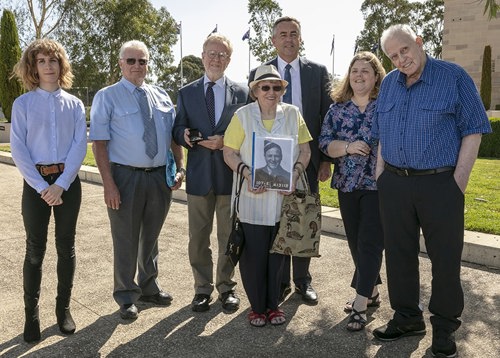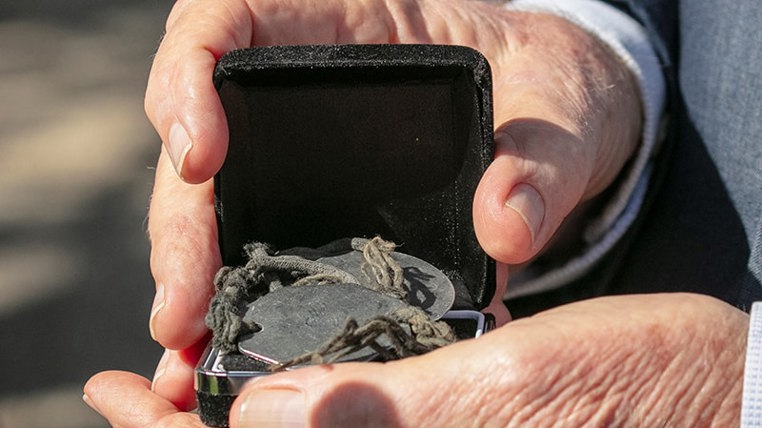07 August 2020
Finding the Family of Kevin Fell
In 2019, a set of military ID tags were discovered in a house in Héricourt, northern France. Like a tale from a mystery novel, the metal discs had lain dormant in an attic since World War Two when a British aircraft was shot down by German forces. Seventy-five years later, Dr Jacqui Donegan, from the Office of Australian War Graves, was tasked with finding the airman’s descendants.

Minister for Veterans’ Affairs Darren Chester (at rear right) with Repatriation Commissioner Don Spinks AM (at rear left) and members of Flight Lieutenant Fell’s family, including his half-brother Kevin Fell (centre), his nephew Kevin Fell (second from left) and his half-sister Gai Winter (third from right).
At the Office of Australian War Graves, we use historical research to locate missing servicemen and women, their descendants, graves and life stories.
There is always more to every story. If you look and look again, a contingent truth will give way and form the basis of a new understanding. This was the case with the set of identity discs belonging to an Australian airman, Flight Lieutenant Kevin Fell.

Flight Lieutenant Kevin Fell’s military ID tags.
Firstly, I had to find out a little about his background. His service war records at the National Archives of Australia revealed that, before enlisting in the Royal Australian Air Force, he worked as a rates clerk at the local council in the country town of Forbes, west of Sydney, and his dad was editor of the newspaper.
I sensed the Fells were well known and integral to their community in the 1940s, and they probably had an enduring presence in the region. At the same time, I had to be mindful of privacy laws and considerations.
By searching online I found a photo of young Kevin Fell in 1937 with his council colleagues, held by the Forbes Historical Museum. If there was one photo, the museum would probably hold others and it would know of Kevin’s living relatives.
In the meantime, I used Ancestry to sketch a family tree; This revealed that, after the war, Kevin’s father had remarried and there was a subsequent Kevin Fell, most likely named in honour of his fallen half-brother.
Now I knew more about his background, it was time to enlist the help of others. I called the Forbes Historical Museum and outlined my inquiry. To my joy, I discovered it did have artefacts relating to the local war hero, as well as contact details for his half-brother.
While I waited for a response, I got on to the historical details. What I found was fascinating:
Flight Lieutenant Kevin Fell, 31, was an exceptional pilot, renowned for his zeal and determination. He undertook at least 15 bombing raids over Europe before his final mission on 15 March 1944.
On this day, he took off from RAF Snaith, Yorkshire, on an air raid to Stuttgart, Germany, but did not return to base.
In Occupied northern France, the townsfolk of Héricourt noticed a large fire burning on the edge of the city. The Halifax (HX330) had been shot down by a Luftwaffe night-fighter and exploded mid-air, crashing into a factory hangar and killing all seven crew.
The local gendarmes attended and, under the watch of German troops, conducted a military funeral at Haute-Saône Communal Cemetery. (These graves were later relocated to the Choloy War Cemetery, managed by the Commonwealth War Graves Commission.)
In an interview in 1985, the Héricourt school principal, Pierre Hass, recalled the events of 1944: ‘The people sent many wreaths and others in French colours. … Over the next few days, the entire population of our region marched past the graves of the English aviators, bringing new flowers and wreaths.
Back in Australia, news of the crash rocked the people of Forbes; they were grief stricken, none more so than Kevin’s young wife, Elsie. The couple had married just two years earlier.
Returning to the present, Forbes Historical Museum confirmed it had located Kevin Fell (jnr), a retired mathematician from Newcastle, north of Sydney.
When he called our office, Kevin was understandably moved, sentiments he expressed publicly when the ID tags were presented to him at the Australian War Memorial a few months later.
Kevin said, ‘I felt amazed by this discovery. It was just such a surprise and I had absolutely no expectation this could ever happen.
We never knew Kevin, but my sister Gai and I both witnessed the grief experienced by our father and his pride and love for his eldest son.
The ID tags were something he was wearing when he died. We’ve only ever had photographs of him and some stories, so to have something so closely connected with him is quite emotional.’
At the presentation, the Fell family brought with them Kevin’s memorabilia, including his war medals, which I noticed looked relatively new.
With the job done, it was time to move on to the next case, but questions persisted. How were the ID tags discovered? Where was the house in France? And what was life like for Elsie, living in a long stretch of loneliness, all those years without her husband?

So, I asked those questions. I located the doctor who had recently bought the house in Héricourt and in turn he recounted the find.
Dr Giles Lazar told me that his ‘wife found the box when she was cleaning the attic and she realised how important it was.
We were very emotional when we looked through the contents of the box and saw how detailed the information was.
I asked the previous owners of the house if they would agree to give the box to the local Remembrance Committee and they agreed immediately.’
Dr Lazar also explained how the tags came to be at his residence.
‘Our house was one of the headquarters for the Resistance in the Héricourt area during World War Two. Monsieur Jeand Heur, nicknamed the Trapper, had chosen it as his hiding place.’

The former Resistance house where the ID tags were found.
Back in Canberra, I wanted to know Elsie’s story (those newish looking medals) so I applied for full access to the World War Two service record of Flight Lieutenant Kevin Fell.
In the file was a letter she had written to the Department of Defence. In 1996, at the age of 83, she wanted to receive her husband’s war medals, something that was unbearable 50 years earlier.
Four medals, including the Aircrew Europe Star, were delivered to Elsie and remained with her, until she died a year later and was remembered as ‘wife of Kevin Fell’.
In a homecoming of sorts, those medals have been united with the ID tags. The Fell family have donated all of Kevin’s military memorabilia to the people of Forbes, acknowledging the town’s war heritage and honouring one man’s service and sacrifice.

